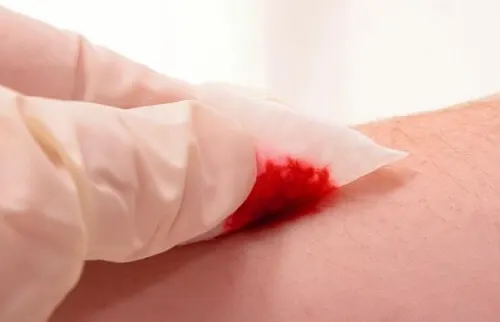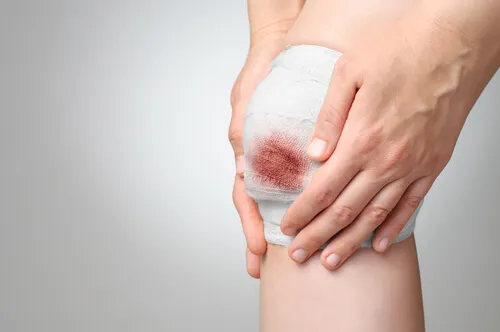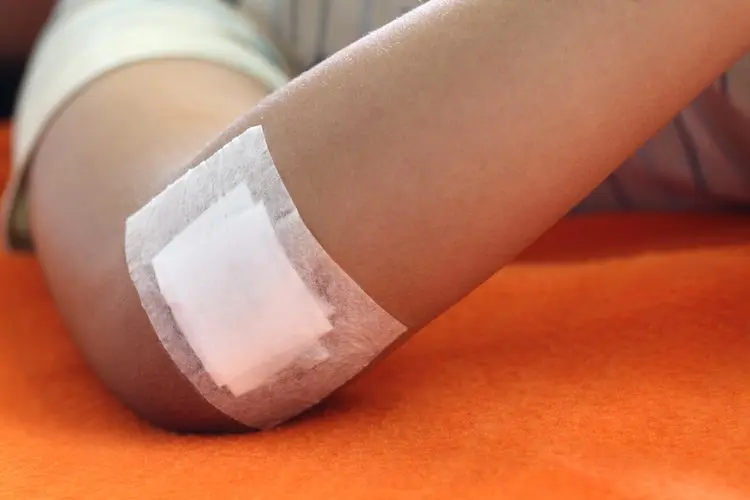How to Prevent a Wound from Becoming Infected

Small cuts or superficial scrapes can be treated at home. However, if it’s a minor wound and not necessary to go to a health center, it’s still necessary to take certain steps to prevent a wound from becoming infected.
Before thinking about healing a wound at home, you first have to see its characteristics. Let’s take a look!
How to prevent a wound from becoming infected
first, it’s important to assess whether the wound is large or deep enough to require medical attention. If so, expert help immediately. It’s also always important that the best cure is prevention.
That said, we’ll give you some tips to prevent a wound from becoming infected at home and thus help it heal.
Stop the bleeding
To begin with, when treating a wound, you should wash your hands thoroughly with soap and water. This will prevent the spread of germs or bacteria to the person who is injured.

Use a clean cloth, rag, or cloth to gently press down on the affected area. Pressure helps the blood clotting process. The ideal time to apply pressure is between 20 and 30 minutes.
On the other hand, to prevent bleeding in the extremities, it’s recommended to elevate the injured body part above the heart:
- The arms or hands can be held in the air or placed on a surface that is higher than the chest.
- The legs or feet can be elevated on a pile of pillows (for example).
You’d definitely like this article: 8 Healthy Foods that are Trending in 2021
Clean to prevent a wound from becoming infected
Cold water is ideal. This will drag particles of sand, dirt, or any trace of dirt that can cause an infection. The skin around the wound should be washed with soap and water and then dried with a towel.
- If any particles remain in the wound, they should be carefully removed. Do this with eyebrow tweezers that have been previously sterilized with alcohol.
- Large particles or embedded objects must be removed by a healthcare specialist. By doing it at home, you may just inflict more damage.
- Avoid the use of alcohol. This is because it can cause irritation and delay the healing process. It’s also not advisable to clean the wounds with cotton balls, as this material leaves behind a residue.
Apply topical antibiotics and cover the wound
There are creams and ointments with different active ingredients to clean wounds on the market. The function of these creams is to prevent infection, not to speed up the recovery process.

Overall, this is the most effective way to prevent the wound from becoming infected. If the wound is small, an adhesive bandage can be used.
Apply a bandage
- Those allergic to the glue in bandages can opt for gauze and adhesive bandages. Also, there are hypoallergenic options on the market.
- When bandaging, it’s not necessary to tighten too much. Applying too much pressure with the bandage can obstruct circulation.
- The bandage should be changed daily until the wound heals. If it gets dirty or wet, it’s also advisable to replace it.
- Finally, remember to avoid the temptation to remove the bandage constantly to see if the wound is healing.
Keep an eye on the wound
All the necessary steps are followed to prevent a wound from becoming infected. However, it’s best to remain alert and observe its evolution. If any of the following symptoms occur, you have likely become infected. In any of these cases, it’s best to seek help.
Seek professional help if the wound:
- Does not heal.
- Hurts more.
- Turns red.
- Forms boils.
- Presents pus-like secretions.
- Feels “hot.”
- Causes a fever.

What types of wounds need medical attention?
Certain wounds should not be treated at home, as the life of the affected person can be put at risk. These are:
- Animal bites. They have a high probability of becoming infected.
- Wounds in which the sensation of the affected limb is lost. Not feeling a part of your body can be an indicator of a serious tendon or bone injury.
- Wounds more than 5 centimeters deep. They may require stitches.
- Wounds with embedded objects such as glass, wood, or stones. Attempting to remove these objects can cause tears and bleeding.
Treatments to prevent a wound from becoming infected
The most common medical treatments for infected wounds are the following:
Stitches
- Here, the doctor uses sterile thread to close the wound.
- Then, they remove the stitches after a few days. The time will depend on the extent of the wound.
- Stitches should never be removed at home, as injury and infection can occur
Adhesive strips
These keep the wound closed in a similar way to stitches. They should never be removed by the patient. This must be done by the doctor.
Tissue glues
Also called tissue adhesives, these are substances that keep wounds or lacerations closed. They are recommended for small wounds. Their use is ideal in children, since their application is painless.
Prevention is better than a cure to prevent a wound from becoming infected
What about you? What experiences do you have with wound infections?
Wounds are certainly not something pleasant and can indeed be dangerous. For this reason, we hope that these tips serve as a mere guide.
No matter what, it’s important to go to the doctor for advice when treating a wound.
Finally, it’s also important to remember that prevention is far better than cure, and preventing any type of injury from becoming infected is one of the essential steps to heal healthily.
Main image courtesy of © wikiHow.com
All cited sources were thoroughly reviewed by our team to ensure their quality, reliability, currency, and validity. The bibliography of this article was considered reliable and of academic or scientific accuracy.
- Diegelmann, R. F. (2004). Wound healing: an overview of acute, fibrotic and delayed healing. Frontiers in Bioscience. https://doi.org/10.2741/1184
- Ruiz, E. F. (2013). Antisépticos y desinfectantes. Enfermedades Infecciosas y Microbiologia. https://doi.org/10.1093/eurheartj/ehr323
- Salem, C., Pérez, J. A., Henning, E., Uherek, F., Schultz, C., Butte, J. M., & González, P. (2000). Heridas: Conceptos generales. Cuadernos de Cirugía. https://doi.org/10.4206/cuad.cir.2000.v14n1-15
- Velázquez RVR, Flores ÁMG, Gómez PBA. Tratamiento de heridas por mordeduras de perro en región craneofacial. Rev Odont Mex. 2013;17(4):247-255.
This text is provided for informational purposes only and does not replace consultation with a professional. If in doubt, consult your specialist.








